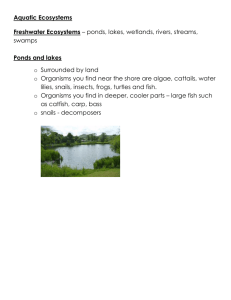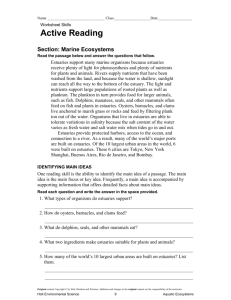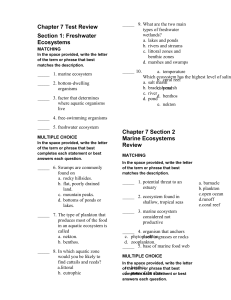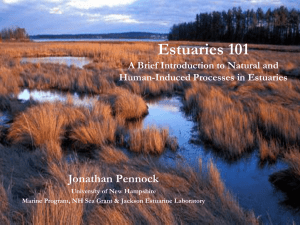Aquatic Ecosystems & Biomes Student Practice (3.3)
advertisement
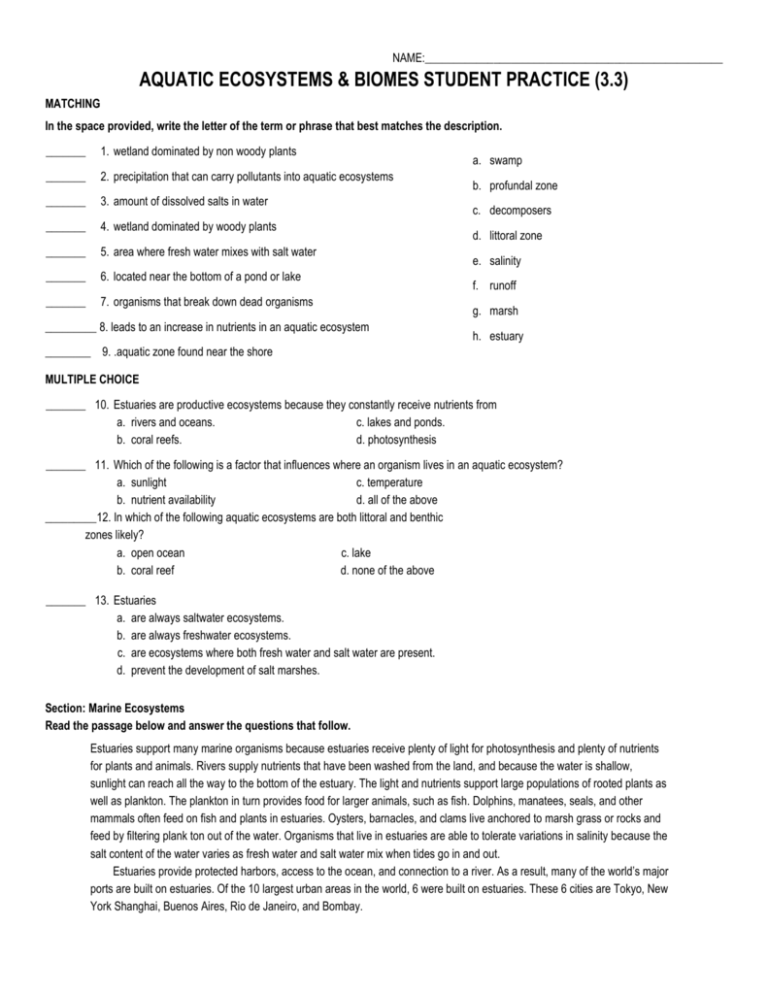
NAME:____________________________________________________ AQUATIC ECOSYSTEMS & BIOMES STUDENT PRACTICE (3.3) MATCHING In the space provided, write the letter of the term or phrase that best matches the description. _______ 1. wetland dominated by non woody plants _______ 2. precipitation that can carry pollutants into aquatic ecosystems _______ 3. amount of dissolved salts in water _______ 4. wetland dominated by woody plants _______ 5. area where fresh water mixes with salt water _______ 6. located near the bottom of a pond or lake _______ 7. organisms that break down dead organisms _________ 8. leads to an increase in nutrients in an aquatic ecosystem a. swamp b. profundal zone c. decomposers d. littoral zone e. salinity f. runoff g. marsh h. estuary ________ 9. .aquatic zone found near the shore MULTIPLE CHOICE _______ 10. Estuaries are productive ecosystems because they constantly receive nutrients from a. rivers and oceans. c. lakes and ponds. b. coral reefs. d. photosynthesis _______ 11. Which of the following is a factor that influences where an organism lives in an aquatic ecosystem? a. sunlight c. temperature b. nutrient availability d. all of the above _________12. In which of the following aquatic ecosystems are both littoral and benthic zones likely? a. open ocean c. lake b. coral reef d. none of the above _______ 13. Estuaries a. are always saltwater ecosystems. b. are always freshwater ecosystems. c. are ecosystems where both fresh water and salt water are present. d. prevent the development of salt marshes. Section: Marine Ecosystems Read the passage below and answer the questions that follow. Estuaries support many marine organisms because estuaries receive plenty of light for photosynthesis and plenty of nutrients for plants and animals. Rivers supply nutrients that have been washed from the land, and because the water is shallow, sunlight can reach all the way to the bottom of the estuary. The light and nutrients support large populations of rooted plants as well as plankton. The plankton in turn provides food for larger animals, such as fish. Dolphins, manatees, seals, and other mammals often feed on fish and plants in estuaries. Oysters, barnacles, and clams live anchored to marsh grass or rocks and feed by filtering plank ton out of the water. Organisms that live in estuaries are able to tolerate variations in salinity because the salt content of the water varies as fresh water and salt water mix when tides go in and out. Estuaries provide protected harbors, access to the ocean, and connection to a river. As a result, many of the world’s major ports are built on estuaries. Of the 10 largest urban areas in the world, 6 were built on estuaries. These 6 cities are Tokyo, New York Shanghai, Buenos Aires, Rio de Janeiro, and Bombay. IDENTIFYING MAIN IDEAS One reading skill is the ability to identify the main idea of a passage. The main idea is the main focus or key idea. Frequently, a main idea is accompanied by supporting information that offers detailed facts about main ideas. Read each question and write the answer in the space provided. 1. What types of organisms do estuaries support? ______________________________________________________________________________________ 2. How do oysters, barnacles, and clams feed? ______________________________________________________________________________________ 3. What do dolphins, seals, and other mammals eat? ______________________________________________________________________________________ 4. What two ingredients make estuaries suitable for plants and animals? ______________________________________________________________________________________ 5. How many of the world’s 10 largest urban areas are built on estuaries? List them. ______________________________________________________________________________________ ______________________________________________________________________________________ Compare and Contrast: Using a double bubble diagram compare and contrast the following terms: 1. River and Lake 2. Oligotrophic and Eutrophic 3. Marshes and Swamps 4. Photic zone and aphotic zone 5. Intertidal zone and Benthic Zone

